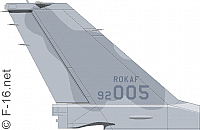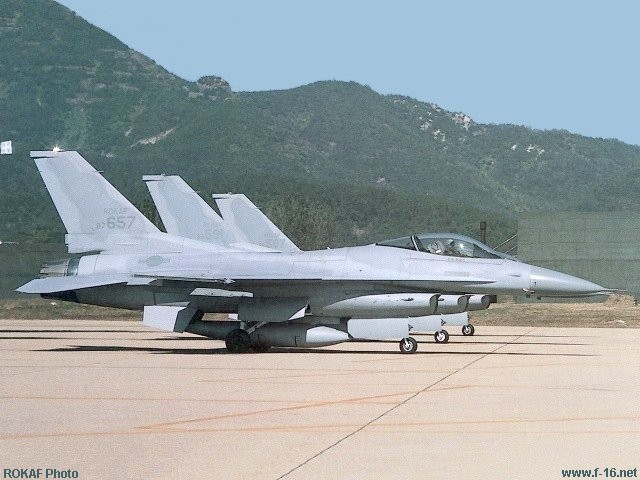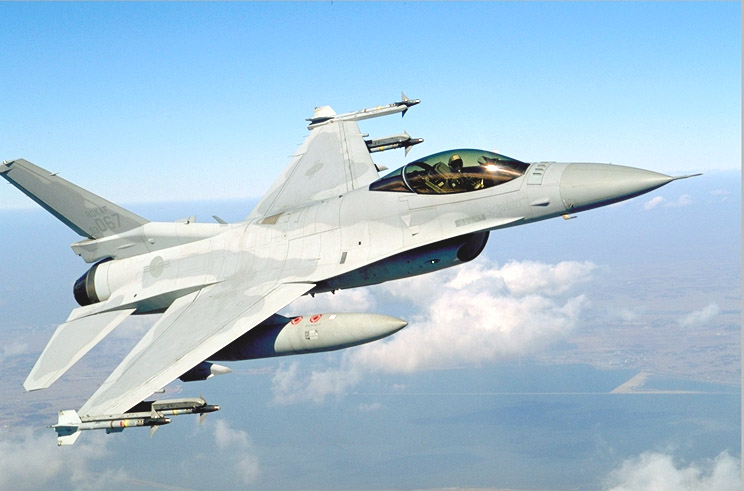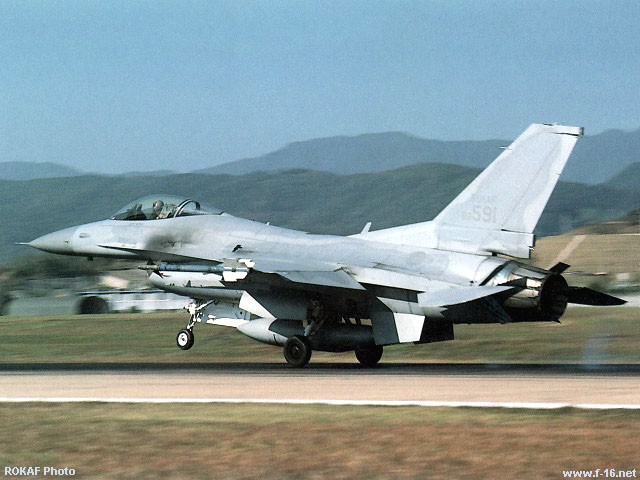 |
South Korea
Han-guk Kong Goon
|
Introduction
The Republic of Korea Air Force operates a total of 180 F-16C/D aircraft, and was the second air force to fly the F-16C/D. South Korea has both block 30 and block 52 aircraft (locally designated KF-16) in its inventory, and is the 5th country with an F-16 production line.
History
The Republic of Korea, or South Korea as it is often referred to, faces a heavily-armed North Korea which is armed with up to 600 tactical jet aircraft. To counter this threat, in the early 1980s South Korea started looking for a 3rd generation fighter to expand its fleet of combat aircraft, which consisted primarily of F-4D/E Phantoms and F-5E Tiger II fighters.
Inventory
Peace Bridge I
In December of 1981, the Republic of Korea signed a letter of agreement for the purchase of 36 F-16C/D block 32 Fighting Falcons under the Peace Bridge I Foreign Military Sales program.
This made the Republic of Korea Air Force (ROKAF) the first foreign operator of the F-16C/D model of the Fighting Falcon. These aircraft were to augment the F-4D/E Phantoms and the F-5E Tiger II's, which were at that time the primary combat aircraft serving with the ROKAF. The Korean program was christened Victory Falcon in 1986 by Chun Doo Hwan, president of the Republic of Korea. Because there were still funds remaining in the Peace Bridge I program, four more F-16D Block 32's were ordered in June of 1988.

Peace Bridge II
In the more ambitious Korean Fighter Program (previously known as the F-X program), the F-16 lost out to the F/A-18 Hornet at first. On December 18, 1989, the Korean government announced that they were going to acquire 120 examples of the F/A-18. The decision was based in part on a lucrative offset offer under which most of the F/A-18s would be manufactured in Korea. However, the planned purchase of 120 Hornets by Korea got bogged down in funding technicalities, and Korea opted for 120 more F-16s instead. They will all be manufactured to the Block 52 standard, and will have upgraded avionics and Pratt&Whitney F100-PW-229 engines.
Locally, the F-16s will be designated KF-16. Under the terms of the agreement, Lockheed Fort Worth will manufacture the first 12 aircraft, the next 36 will be delivered in kit form and assembled in South Korea, whereas the last 72 will be built in South Korea by Samsung Aerospace. This makes South Korea the 5th country to produce the F-16, after the US, Belgium, the Netherlands and Turkey. Major subcontractors are Daewoo and Korean Air. The expertise gained in the program will be put to use in the Korean Trainer Experiment program. South Korea took delivery of the first of these (LMTAS-built) aircraft on December 2nd, 1994.
On June 30th, 1997, a ceremony to commemorate the delivery of the first local-built KF-16 was held at Samsung Aerospace's Sachon plant in the Kyungsang Province. The KF-16 consisted of more than 349,000 different parts.

Peace Bridge III
On July 27th, 2000, the Korean government decided to buy another 20 F-16s, consisting out of 15 C's and 5 D's, all of the advanced Block 52 version. These aircraft are also to be produced locally by Korean Aerospace Industries in a $700 million program. These new aircraft will be delivered in the 2003-2004 timeframe. This makes it possible for the ROKAF to equip another squadron with F-16 fighters, in replacement of the aging F-4 or F-5 fighters still in service with the ROKAF.
| Program | Model | Block | Qty. | Serials | Delivered |
|---|---|---|---|---|---|
| Peace Bridge I | F-16C | Block 32 | 30 | 85-574/85-583 86-586/86-597 87-653/87-660 |
1986-1992 |
| F-16D | Block 32 | 10 | 84-370/84-373 85-584/85-585 90-938/90-941 |
1986-1992 | |
| Peace Bridge II | F-16C | Block 52 | 80 | 92-001/92-028 93-049/93-100 |
1994-2000 |
| F-16D | Block 52 | 40 | 92-029/92-048 93-101/93-120 |
1994-2000 | |
| Peace Bridge III | F-16C | Block 52 | 15 | 01-510/01-524 | 2003-2004 |
| F-16D | Block 52 | 5 | 01-525/01-529 | 2003-2004 |
Modifications & Armament
Armament
The Block 52 machines will be equipped to carry the LANTIRN night navigation/targeting pod system and will be able to carry and fire the AIM-120 AMRAAM and the AGM-88 HARM anti-radiation missile.
South Korea has purchased AIM-9 Sidewinder, AIM-120 AMRAAM, AGM-65 Maverick, and AIM-7 Sparrow missiles for its F-16 force.
AN/ALQ-165 Airborne Self-Protection Jammer
South Korea is the first international customer to incorporate the AN/ALQ-165 Airborne Self-Protection Jammer in its F-16s. ASPJ is the fourth type of internal electronic countermeasures equipment that has been integrated into the F-16. ASPJ is a state-of-the-art internal electronic countermeasures system used to defeat or degrade tracking by threat radar systems and will enhance the survivability of the F-16 in combat. The system is built by a team of Northrop Grumman and ITT and is currently in service with some fighters in the U.S Navy, Marine Corps and several international customers' versions of similar fighters.
The modernization program to install the AN/ALQ-165 Airborne Self-Protection Jammer (ASPJ) in ROKAF Block 52 F-16s began in April 1997. On February 26th, 1999, Lockheed Martin Tactical Aircraft Systems (LMTAS) delivered the first Korean F-16 modified with the AN/ALQ-165 Airborne Self-Protection Jammer (ASPJ). The ASPJ countermeasures set will give the Republic of Korea Air Force (ROKAF) F-16s a robust self-protection capability. These aircraft also have the ALR-56M radar warning receiver and the ALE-47 chaff/flare dispenser.
The first aircraft to be modified was delivered in late 1994 and was flown back to the United States for modification and testing. This aircraft was modified at Fort Worth, will undergo testing in the anechoic chamber, and will then be ferried to Edwards Air Force Base, California, for several months of flight testing.
The remainder of the F-16s scheduled for the ASPJ upgrade were modified in Korea by the ROKAF beginning in mid-2000.
Midlife Update
In December of 2013 the Korean government signed a contract with BAE to upgrade 134 of its F-16 fighters. This update will see the oldest airframes being equiped with the latest Modular Mission Computer and associated equipment, bringing them back to par with the last Peace Bridge III ordered F-16s. Moreover it was also decided to replace existing AN/APG-68(V) radars with the Raytheon RACR Active Electronically Scanned Array (AESA) radar as well
The RACR distills the best of the AESA family into a compact package of advanced multimode capability. Lightweight and powerful, RACR is a formidable force for aircrew survivability and mission success. RACR gives decisive tactical advantages:
- Higher resolution and longer standoff range;
- 5 to 10 times more operational availability than MSA radars;
- Simultaneous detect, identify and track multiple air and surface targets.
Operational Service
Units
Please refer to the F-16 Units section for an overview of units.Please use this form to add any list any error or omissions you find in the above text.
Note: your comments will be displayed immediately on this page. If you wish to send a private comment to the webmasters, please use the Contact Us link.

